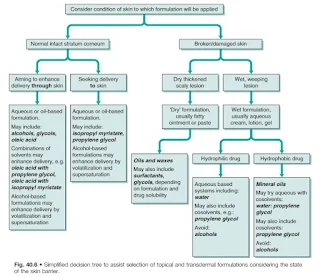Topical Preparations
Introduction
In an overview, transdermal formulations aim to deliver the drug to therapeutically active levels at the target site (either local or systemic) through skin.
- It has been estimated that for topical products such as creams and gels, typically only between 1% and 3% of the applied dose is bioavailable.
- Bioavailability from patches is typically 30% to 70% for drugs such as buprenorphine and fentanyl.
NOTE: Topical treatments used for local effects have a decreased incidence of systemic side effects and generally provide faster relief. But, local reactions may occur as side-effects.
Formulation Options
Generally,
- Semisolid formulations are selected for increased residence on the skin;
- Transdermal patches are selected for extended drug delivery through the skin;
- Liquid formulations are selected for a rapid short-term input of permeant into the skin.
Cream or Ointment
At work (being at a hospital pharmacy or community pharmacy), we may find certain topical products come in both cream and ointment form, such as fusidic acid cream and ointment.
- Creams contain more than 20% water and up to 50% oil. They spread easily and are reasonably hydrating.
- Lotions contain the most water (compared to other topicals), are more fluid than creams and can be poured. They are easy to spread on the skin and they absorb quickly.
- Ointments contain the least water; 0-20% with the remainder composed of oil-based product(s). Ointments are good delivery vehicle to provide a barrier to exposure (e.g. organisms, sun) and they prevent moisture loss which helps burn and scar healing.
As a pharmacist, which product will you recommend? And more importantly, why? Factors affecting formulation type of topical therapy.
- Depending on the lesion type,
- For a wet, vesicular or weeping lesion, a 'wet' (usually aqueous-based) formulation is generally preferred, such as cream, lotion or gel.
- For a dry, thickened scaly lesion, a 'dry' (usually fatty) formulation is preferred, such as an ointment or paste.
- The skin site to be treated can affect the selection of the vehicle.
- For hairy areas, lotions, gels or sprays are usually preferable.
- For intertriginous areas (sites where skin may touch or rub such as the axilla of the arm), creams or lotions are usually preferred.
NOTE: Beyond the broad nature of the vehicle, specific formulation components may be required, dependent on the physicochemical properties of the drug (e.g. the drug pKa and the need for a buffer, the stability of the drug and the need for an antioxidant), clinical considerations (e.g. intact or broken skin, duration of use) and to improve patient adherence.


hi
ReplyDelete